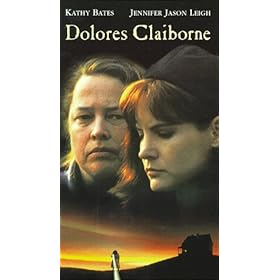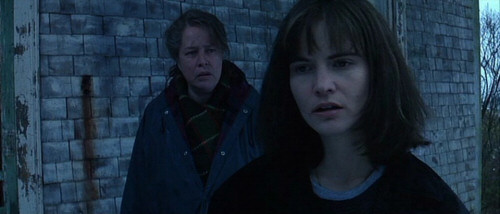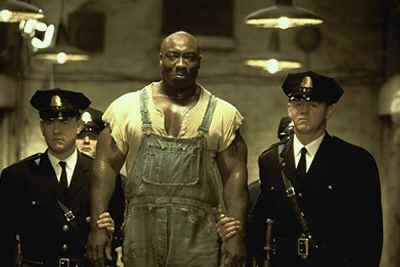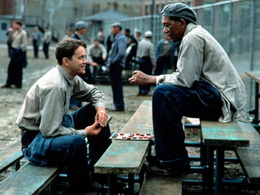So without further ado…
13. Dolores Claiborne (1995)

Probably the most understated tale on our list, Dolores Claiborne stars Kathy Bates and Jennifer Jason Leigh, two of Hollywood’s top female leads, in a story of secrets and decades of physical and sexual abuse brought to a sudden halt by a mother pushed too far. What pulls this from the ranks of Lifetime Television’s “All-Men-Are-Fuckers-And-Deserve-Death” fodder is King’s down home country wit, and how realistic his characters feel to the viewer. Directed by Taylor Hackford, an uber talented filmmaker, the story is dark and moody, and conveys almost a white trash noir feel. Kathy Bates is spot on as Dolores, a woman who commits the ultimate sin to keep her daughter safe, and now must deal with that daughter’s bitterness and troubled life. The cinematography is brilliant; the dialogue straight from the book.

12. The Mist (2007)

An old hand at finding the perfect way to tell a King story, Frank Darabont (director of two more films on our list, so he must be doing something right) tackled his first true Stephen King horror movie and knocked it out of the park. ‘The Mist’ is like ‘Lord of the Flies’ meets H.P. Lovecraft as two anxious and emotionally unstable factions fight the beasts outside in the sudden paralyzing mist and each other. This is a story Roger Corman would have loved. In fact, at times, it resembles that cheapo classic, ‘Day the Earth Ended’, only with a huge budget for a multitude of ugly CGI driven monsters. ‘The Mist’ is peopled by a cast of past King film actors and actresses and they do a fine job of conveying the panic and despair of being thrust into a world gone mad. But it’s Thomas Jane’s solid good guy father lead that makes it all work. Some fans had issues with the ending, but, hey, it’s a fucking horror film, man. What did you expect?

11. Creepshow (1982)
.jpg)
Ah, the 80s…this collaborative anthology horror-comedy effort between two horror giants, George Romero (directing) and Stephen King (screenplay and actor), could only be made in the 80s, when horror was king. This was their attempt at bringing the gaudiness and dark fun of the old E.C. horror comics to the big screen. And it works rather well. The stories are mostly revenge oriented, the colors as brightly dark as a carnival sideshow, the cast tongue-in-cheek- including Stephen King himself as the lead in "The Lonesome Death of Jordy Verrill"- each story paneling into the next smoothly. I mean, check out this cast: Hal Holbrook, Adrienne Barbeau, Leslie Nielsen, Ted Danson, E. G. Marshall, Ed Harris, and Tom Atkins…and a very young Joe King, who now goes by Joe Hill, and has become a bestselling horror author in his own right (Heart-Shaped Box and 20th Century Ghosts). If you want to just have fun watching some funny scary mini-movies, this is the one to try.

10. The Stand (1994)

The very fact that Mick Garris, a man who continues to defy logic in getting one King project after another handed to him for defilement, actually didn’t screw this mammoth King novel is amazing. It is, in fact, pretty darn good. It has to be, clocking in at around 366 minutes. But let’s be honest: this may be the best thing Stephen King has ever written. How could anyone, even Mick Garris, mess it up? Made for television, you won’t get any of the nastier parts of the novel, but that’s okay. Because what you get is more important: great characters who grow on you and whom you actually care about. King does what he does best in The Stand, pitting two struggling factions of survivors against one another in a world gone to Armageddon in a test tube. The first part of this huge TV event covers how the world ends; the next is about who survives and how they come together into two groups- the good and the bad; and the last is about the final battle between them. King layers his story with spiritual and philosophical subtexts that work to make this a big tale. The only thing that kept this one from being much higher up the list was some of less-than-satisfactory casting choices, the biggest issue being Jamie Sheridan playing Randall Flagg, The Walking Dude. The villain in The Stand is probably the single most important character- he drives the McGuffin along in a dark and scary way. Sheridan just doesn’t have the pizzazz to pull it off. But all in all, the casting was pretty well done, including Gary Sinise as Stu Redman, the next most important character in the film. Sinise goes a long way in making up for some of the deficiencies in other casting choices.

9. The Green Mile (1999)

Frank Darabont’s second King adaptation is a beautiful story of redemption and miracles. Starring Tom Hanks, David Morris, Jeffrey DeMunn, Barry Pepper and Michael Clarke Duncan, as John Coffey, this is Stephen King at his best. The Green Mile took Hollywood by storm, garnering several Oscar nominations and tons of industry awards besides. Set in 1935 at Louisiana’s Cold Mountain Penitentiary, it tells the tale of convicted murderer, John Coffey, a huge mountain of a man, accused of a crime he did not commit, but because of his simple childlike mind, he is unable to prove otherwise. Tom Hanks plays the officer in charge of The Green Mile, the green tile hall that leads from the cells where those sentenced to death serve out their remaining days to the execution chamber. The corrections officers form a friendship with Coffey and discover he has the ability to heal the sick and the dying with a touch of his hand. Too bad he’s going to be executed, right? Think of all the good he could do it given a chance in the real world. There are moments of fragile beauty and brutality in The Green Mile that will leave you haunted and disturbed. The acting, one and all, is topnotch and engrossing. And by this film Darabont’s filmmaking talents are on par with any top director in the business, as he weaves the past and the present seamlessly. If you don’t cry during this movie, you’re a hard nail, my friend. A hard nail, indeed.

8. IT (1990)

While not as massive an undertaking as The Stand, this was King’s second television mini-series event based on his work- the first being ‘Salem’s Lot’ (see below). Putting this alongside his novella ‘The Body’ (see below, ‘Stand By Me’) from his collection of novellas, ‘Different Seasons’ , it’s his love letter to his childhood pals and his long ago hometown. But beyond all that, this is one hell of a scary story, aptly captured on the small screen by that John Carpenter protégé’, Tommy Lee Wallace (director of such horror classics as Halloween III: Season of the Witch (1982) and Fright Night 2 (1988)). The highlight of this story of seven childhood friends who come together as children and later as adults to fight an ancient evil buried beneath their town is without a doubt Tim Curry as Pennywise the Clown. He has got to be the most menacing clown ever to don a shiny red nose and greasepaint. Yes, there are some silly moments that don’t translate well from the novel to the small screen, but overall, again, it’s the great casting that saves this from TV wasteland. The adult versions of the characters truly are some of the best of their time: Harry Anderson, Dennis Christopher, Richard Masur, Annette O'Toole, Tim Reid, John Ritter, and Richard Thomas- and each bring a solid performance to the table to keep the viewer engrossed and sympathetic. But let’s not sell the childhood cast short. With an earnest story of lost childhood, this was a dream job for such child actors as Seth Green and Jonathan Brandis. ‘IT’ is a near perfect balance of the bittersweet and the terrifying.

7. The Dead Zone (1983)

This is the underrated classic of the list. A lot of King fans have forgotten the power of this 1983 adaptation by director David Cronenberg. It is bleak and unlovely, but powerful in telling the story of Johnny Smith, a man who is set for future happiness but is suddenly thrown into a five year long coma after a devastating car crash. All he has come to love and know is gone by the time he awakens. Worse still, while he has been in physical hibernation for half a decade, he has gained the power to read a person’s future or past by physical contact. His new found powers alienate him even further from his fellowman. He tries to rekindle his dead romance with his old sweetheart, now married and with a child, but ultimately, it is, like Smith, doomed. Smith’s final days are spent struggling with his inner demons when he makes accidental contact with an evil politician who he foresees will one day bring about the end of the world through nuclear annihilation. Smith becomes a would be assassin to save humanity…but…well, just see the movie, right? I don’t want to spoil it for you. Again, we have some top talent working on this film. The cast alone is worth the viewing: Christopher Walken, Tom Skerritt, Martin Sheen, Herbert Lom, Brooke Adams, Anthony Zerbe, Ken Pogue, and Colleen Dewhurst. But one has to bow to Jeffrey Boam’s excellent screenplay. He pulled the parts of the novel that worked and left out the extraneous stuff that would surely have dragged this picture down. Between King, Cronenberg and Boam the film is loaded with doom and darkness. A thing of beauty.

6. Stand By Me (1986)

Ok…ok…of all the films listed here, this is the one that’s as far removed from a horror film as possible. But how many major Hollywood films are about a bunch of kids going to look at a dead body for kicks? Sure, you’ve got your sandlots, your treehouses, and even your Dog Skippys, but a dead body? Directed by Rob Reiner, this is the past to present story of four friends (Wil Wheaton, River Phoenix, Corey Feldman, and Jerry O'Connell) who take a long walk through the woods to see the dead body of a kid who’s been struck and killed by a train. It’s about lost innocence and the power of childhood friendships, about fighting for survival in the small town cesspool of thugs and sneering judgmental adults, it’s about how much emotional hurt kids endure in growing up…and it’s about a dead body. Did I mention that yet? Everything works in ‘Stand By Me’, from the soundtrack to the simplistic, yet powerful, filming style. It’ll get you in the heart and squeeze tears from your eyes, folks. One last word: this film stars a young River Phoenix, in probably his finest performance up to that date. If this movie does nothing else, it should serve as a time capsule for a damn great actor who could have gone on to become the biggest name in the business. No offense to Wheaton, Feldman or Connelly, but they were nowhere near what Phoenix had at their age.

5. The Shawshank Redemption (1994)

Some critics saw the success of King’s non-horror ‘Stand By Me’ as a fluke, a one off by ‘that horror guy’. But when Frank Darabont, a King fan and fine storyteller in his own right, optioned and filmed another of the novellas (Rita Hayworth and the Shawshank Redemption) from King’s ‘Different Season’ collection, it was hard to ignore the fact that, while some critics will always regard King as just ‘that horror guy’, he is maybe one of the finest American authors of this century. And that is no gross overstatement from a fan- that is a statement of fact from a writer who recognizes the depth and power of the written word and can appreciate Big Steve’s talent and imagination. He makes it look so easy, but it ain’t, folks. With ‘The Shawshank Redemption’, Darabont tackled the tale of a convicted murderer Andy Dufresne (played by Tim Robbins) as he is placed into a maximum security prison called Shawshank State Penitentiary. He’s befriended by an old con named Red (played perfectly by Morgan Freeman), the man who can get you anything inside. It takes place over decades of his imprisonment, in which he must fight for survival against violent sexual predators and a crooked warden who wants to use him even though he is probably innocent of the crime of which he has been accused. How Andy finally escapes the prison is a story of triumph and courage against impossible odds.

4. Misery (1990)

This was director Rob Reiner’s second shot at King material, and Kathy Bates first: both of them nailed the thing. Knocked it right out of the park. The film is a study in creeping menace and oppression, as writer Paul Sheldon (played with tremendous success by James Cahn) is found half dead, lying in the snow, after a horrible car crash by his ‘number one fan’, mousy seeming Annie Wilkes. Wilkes certainly does idolize Paul’s longtime romance character, Misery- to the point of insanity, actually. She keeps him hostage in her isolated farm house, while forcing him to write a new Misery novel just for her. If there is a more terrifyingly menacing character in modern horror cinema (besides perhaps Javier Bardem’s turn at hit man Anton Chigurh in “No Country For Old Men”) I don’t who it might be. Bates plays the role with a subtle professionalism that leads up to the most devastating scene in the movie: when she takes the sledge hammer to Paul’s already crippled legs…just to make sure he doesn’t try any more cacadoody tricks on her. Reiner knows how to tell a subdued story, using the snowy and lonely landscape as an extra character to the film, as he slips up on the suspicious viewer to unleash Annie Wilkes on helpless, trapped Paul Sheldon. How far he must go to save himself is truly one of the magic moments of the film. A must see for any King fan.

3. Salem’s Lot (1979)

After ‘Carrie’s’ success in the theaters, and with King’s bestseller star rising, television scrambled to adapt one of his grittier pieces for the small screen. ‘Salem’s Lot’ was the first time his work was set to reach a much larger viewing audience. Smartly the studio chose another up and coming horror pro to helm the direction, ‘Texas Chainsaw Massacre’s’ Tobe Hooper. Incidentally, this is one of the few times Hooper got it all right, and it probably had a lot to do with his continued success through the 80s. ‘Salem’s Lot’ tells the story of a small town which is being overrun by vampires. King’s book is much more complicated, loaded with subtext, than the mini-series would allow, but for the time you get it, does its job very well. Some scenes have haunted me for decades (the floating vamp kid at the window is one; Geoffrey Lewis’ slow degradation into an undead state is another). There is a sense of doom prevalent throughout the movie, and you just know it ain’t gonna have a happy ending.

2. Carrie (1976)

King’s first time at the big screen, directed with style and eye for emotional entanglement by Brian DePalma, ‘Carrie’ is one hell of a great movie by anyone’s standards. DePalma has moments of pure moviemaking genius. There are no small parts in this one. Every actor and actress brings their A-game to the story of mousy, oppressed Carrie White. She is teased and emotionally assaulted at school, and physically and mentally abused by her overzealous religious mother at home. It seems she is destined to become just another speed bump under the cruel wheels of the high school social machine. But Carrie has a secret power that is just coming to fruition as physical womanhood approaches- she can move things with her mind. Befriended by the coolest guy in school and asked to attend the Prom with him, she thinks life is taking a turn for the better. But all hell breaks loose Prom night and she leaves a trail of mass destruction in her wake. DePalma smartly stayed true to most of King’s novel, and his important religious and social subtexts, and gives the viewer the sense of how desperate Carrie’s doomed existence is. She attains power through a blood sacrament (not once, but twice), and lets loose the terrible power of uncontrolled female power against those who would oppress her. Truly this is a classic piece of 70s cinema, and certainly a horror film that belongs in any horror fan's library.

1. The Shining (1980)

And that brings us to the #1 Stephen King adapted work to date ( I won’t say of all time, because Big Steve is still rock and rolling these days, and he still has the potential to knock something way over the wall again)- ‘The Shining’. Directed by one of the greatest film makers of all time, Stanley Kubrick, this is one of the creepiest movies ever put on celluloid. Kubrick distilled the essence of horror in this movie, and it’s a film that still manages to reverberate along all social lines, adding fans with every new generation. It certainly has to be included in any list of the top horror films ever made. For nearly 30 years this has proven to be the best adaptation of a King novel. Now, a lot of King fans, and even King himself, will argue Kubrick’s vision strays quite a bit from his source material. No argument here, folks. But if you’ve got to have someone use your stuff and then stray off into darker and more unsettling directions you truly could not do better than visual master Kubrick. Again, this is a film loaded with doom, isolation, oppression, and some very dark emotions. Jack Nicholson plays Jack Torrence, a struggling writer and a recovering alcoholic, whose demons are not at rest. When he takes a job as caretaker for a seasonally closed ski resort high in the snowy mountains, he brings along his wife and son (Shelley Duvall and Danny Lloyd). Together they begin to experience horrifying visions of the dead, as the sprawling resort grows stronger as the days pass. It especially tough on Danny because he’s developed a power called The Shining. He can see dead people…and they can see him. When a snowstorm traps them inside, Jack goes apeshit crazy, and begins ranting and raving, talking to dead bartenders, and chasing his family around with a very sharp axe. Danny and his mother run away, but Jack is given a helping hand by the ghosts, who want to trap all of them inside the hotel forever. How Kubrick resolves the crisis is classic Kubrick. This is a masterpiece of cinema by a master of the craft.



--Nickolas Cook
